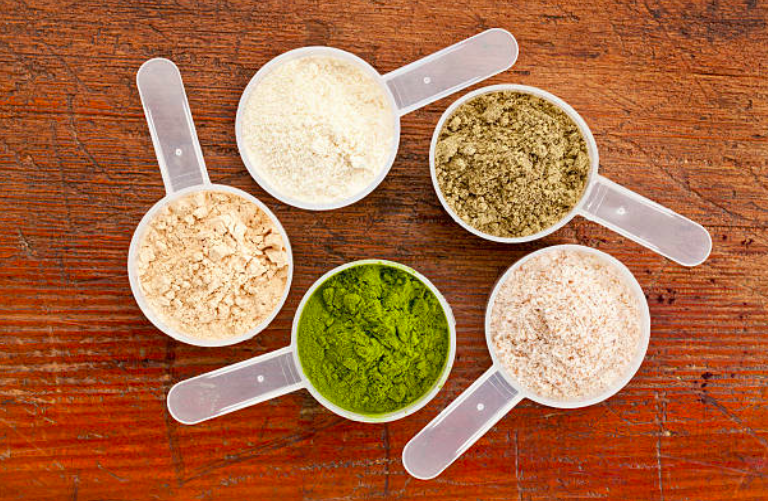The Scoop on Protein Powder
Protein is an important nutrient for our health. Proteins are made of small molecules called “amino acids” that serve as the building blocks for nearly every tissue and chemical in our body. Having an adequate dietary source is important to help control weight and muscle mass, balance blood sugar and prevent cravings, and appropriately drive metabolism.
Adding a scoop of protein powder to a smoothie can be a quick and easy way to boost protein consumption. But not all protein powders are created equal.
Whey
Source: Whey is a protein components in cow’s milk.
Pro: Whey is highly bioavailable, meaning it can be easily used by your body.
Con: Cow’s milk is a common gut irritant that causes low grade systemic inflammation for many people without them ever realizing it.
Good for you if: You are an athlete and want more lean muscle mass. You tolerate dairy well. You get it from a good source (organic, grass-fed, minimal ingredients, no thickeners, no sweeteners).
Casein
Source: Casein is also a protein in cow’s milk.
Pro: Casein is also easily used by the body.
Con: Casein can cause allergic reactions or upset stomach for those with dairy sensitivity. It also takes longer to digest than whey.
Good for you if: You are an athlete and want more lean muscle mass. You tolerate dairy well. You get it from a good source (organic, grass-fed, minimal ingredients, no thickeners, no sweeteners).
Soy
Source: Soybean plant
Pro: Soy is a plant-based protein that is an alternative for those with daily allergies or sensitivities. Soy is one of few plant foods that offers a full profile of amino acids that our bodies need.
Con: Research suggests that some soy consumption is safe, however, some still worry about the hormone-like compounds that soy contains.
Good for you if: You are vegan. You tolerate legumes. You get it from a good source (organic, minimal ingredients, no thickeners, no sweeteners).
Pea Protein
Source: Plants; usually yellow peas.
Pro: Pea protein is considered hypoallergenic meaning it is unlikely to cause an allergic reaction or food sensitivity.
Con: Peas do not contain the full spectrum of amino acids.
Good for you if: You are vegan. You mix it into other blends of protein (e.g. hemp or rice) to get all the necessary amino acids. You tolerate legumes. You get it from a good source (organic, minimal ingredients, no thickeners, no sweeteners).
Rice Protein
Source: Rice
Pro: Rice is also hypoallergenic, plus it may have an extra dose of B vitamins and fiber.
Con: Rice contains a small amount of carbs.
Good for you if: You are vegan. You are not paleo. You mix it into other blends of protein (e.g. hemp or pea) or nuts and seeds to get all the essential amino acids. You tolerate grains. You get it from a good, high-quality source (organic, minimal ingredients, no thickeners, no sweeteners).
Hemp
Source: Hemp seeds (from the cannabis plant)
Pro: Hemp is hypoallergenic and is a source of complete protein. Hemp has all the 9 essential amino acids and contains an extra dose of omegas.
Con: Hemp is the least bioavailable of the lot, meaning your body doesn’t absorb and use it as well as other sources.
Good for you if: You are vegan. You are paleo. You get it from a good, high-quality source (organic, minimal ingredients, no thickeners, no sweeteners).
Collagen
Source: Animal connective tissue
Pro: Collagen can be good for skin and joint health.
Con: This is often considered a beauty product and comes with a lot of the hype. Many label promises are not proven.
Good for you if: You are not vegan. You are paleo. You don’t mind spending a bit extra to get the good stuff. You get it from a good, high-quality source (organic, grass-fed, minimal ingredients, no thickeners, no sweeteners).
Spirulina
Source: Blue-green algae
Pro: Spirulina is a complete protein plus gives extra minerals and antioxidants.
Con: It is hard to know where it comes from.
Good for you if: You are vegan. You are paleo. You tolerate chlorophyll-containing drinks. You get it from a good, high-quality source (organic, minimal ingredients, no thickeners, no sweeteners).
And the winner?
In my opinion, a mixture of rice and pea protein is the winning combo. The combination makes up the full spectrum of essential amino acids, while being plant-based, and free of common irritants like casein, lactose, gluten, or soy.
One final note of caution: unfortunately, the FDA does not regulate protein powders, so you have no way of knowing what’s actually in them. Do your homework to make sure you’re getting protein powder from a trusted source. Ensure your protein powder is free of added sugars and artificial coloring or preservatives. Ideally, it will be certified by a third party stating it is low in heavy metals.

